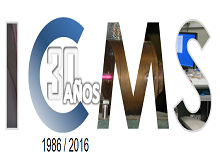Seville, June 28, 2016. The Institute of Materials Science of Seville (ICMS) has commemorated the thirtieth anniversary of its foundation. At an event held on June 27 at the cicCartuja, the scientific results of the Institute in these three decades were reviewed, while various proposals were put forward to address the challenges of future research.
The event was attended by the President of the CSIC, Emilio Lora-Tamayo, the Rector of the University of Seville, Miguel Ángel Castro Arroyo, and the Director General of Research of the Junta de Andalucía, Manuel García León, representing the institutions that co-own the cicCartuja.
For his part, the Director of the ICMS, Alfonso Caballero, summarised the main management indicators of the Institute, highlighting the five major lines of research that are integrated into it: catalysis for the environment and energy, ceramic engineering for extreme environments, mechanochemistry and reactivity of materials, nanostructured functional materials and designer and microstructure nanomaterials.
Caballero also pointed out that more than a hundred people currently make up the scientific staff of the ICMS, including CSIC researchers, university professors, and pre- and postdoctoral researchers. Finally, Alfonso Caballero highlighted that the ICMS publishes around 130 articles annually in international journals, of which approximately 4,000 citations are made per year.
A nod to the past and the future
After Alfonso Caballero, the first Director of the ICMS and one of its founders, the professor of Inorganic Chemistry Guillermo Munuera, spoke. He recalled the beginnings of the centre in the eighties, a time when the foundations for its creation were laid, thanks to the “mobilising programmes” of the CSIC and the initiative of the former Department of Physical and Chemical Research of the University of Seville.
Munuera has emphasised, among others, the figure of the now deceased researcher José María Serratosa, whose impetus was essential for Seville – like Madrid, Barcelona and Zaragoza – to have a leading research centre from 1986 onwards in areas such as solid state physics and chemistry, physical chemistry of surfaces and other disciplines related to materials science.
Next, it was the turn of Hernán Míguez, a research professor at the CSIC, to speak. He delved into the research being carried out by his group on multifunctional optical materials on optical materials, one of the fields with the greatest expectations for materials science in the coming years, due to its potential applications in the business world.
On the other hand, Julián Martínez Fernández, Vice-Rector for Research at the University of Seville, spoke as a professor attached to the Department of Condensed Matter Physics and member of the ICMS, discussing the future possibilities that are opened up by the technological applications of biomimetic materials obtained by pyrolysis.







